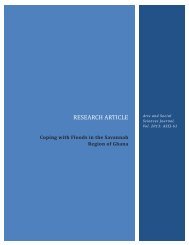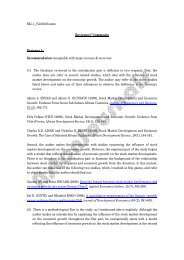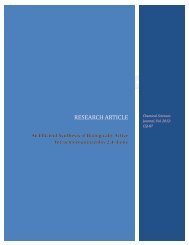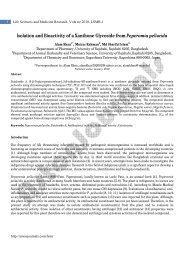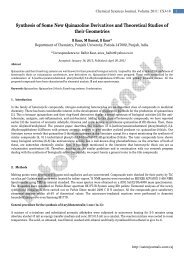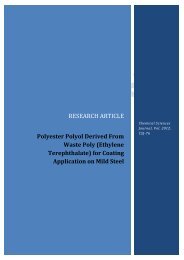Simple, Sensitive and Eco-Friendly Methods for the ... - AstonJournals
Simple, Sensitive and Eco-Friendly Methods for the ... - AstonJournals
Simple, Sensitive and Eco-Friendly Methods for the ... - AstonJournals
Create successful ePaper yourself
Turn your PDF publications into a flip-book with our unique Google optimized e-Paper software.
2 Research ArticleVisible spectrophotometry may serve as a useful alternative to many of <strong>the</strong> a<strong>for</strong>esaid sophisticatedtechniques because of its cost-effectiveness, ease of operation, sensitivity, fair accuracy <strong>and</strong> precision <strong>and</strong> wideapplicability. A few spectrophotometric methods have earlier been reported <strong>for</strong> MDH. Van Urk reagent [10] as achromogenic reagent has been reported <strong>for</strong> <strong>the</strong> determination of MDH in tablets <strong>and</strong> syrup, but <strong>the</strong> method ispoorly sensitive with a narrow linear range 10-24 µg ml -1 . Ano<strong>the</strong>r method, based on <strong>the</strong> reaction of MDH withsodium cobaltinitrite in 85% H 3 PO 4 medium [11] where <strong>the</strong> reaction mixture was boiled <strong>for</strong> 15 min be<strong>for</strong>emeasuring <strong>the</strong> absorbance at 372 nm, has also been reported. Sastry et al. [12] have devised a method involvinghematin <strong>for</strong>med in situ from haematoxylin <strong>and</strong> chloramine-T at pH 7.0 <strong>and</strong> MDH at 70 o C leading to <strong>the</strong> <strong>for</strong>mationof pink colored chromogen measurable at 555 nm. The same authors [13] have reported three procedures basedon oxidative coupling reaction involving MDH, MBTH <strong>and</strong> iron (III), persulphate or hypochlorite. A few indirectmethods are also found in <strong>the</strong> literature. In one method reported by Basavaiah <strong>and</strong> Charan [14], MDH was reactedwith measured excess of vanadate, in H 2 SO 4 medium <strong>and</strong> <strong>the</strong> unreacted oxidant was determined by treating it withH 2 O 2 <strong>and</strong> measuring <strong>the</strong> resulting complex at 460 nm. In a related method by <strong>the</strong> same authors [15], <strong>the</strong> unreactedvanadate was determined by reaction with chromotropic acid in <strong>the</strong> presence of hydroxylamine chloride, <strong>and</strong>measuring <strong>the</strong> absorbance at 420 nm. Using KIO 3 as <strong>the</strong> oxidimetric reagent, <strong>the</strong> same authors [16] have reportedthree methods <strong>for</strong> MDH. In <strong>the</strong> first method, MDH was treated with a measured excess of KIO 3 , <strong>and</strong> <strong>the</strong> unreactedoxidant was reacted with variamine blue, <strong>and</strong> <strong>the</strong> resulting color was measured at 540 nm. In ano<strong>the</strong>r method, <strong>the</strong>drug was reacted with a large excess of iodate in <strong>the</strong> presence of chloride ions, <strong>the</strong> ICl 2 - generated was used toiodinate 2’7’-dichlorofluorescein, <strong>and</strong> <strong>the</strong> red color of <strong>the</strong> iodinated dye was measured at 525 nm. The thirdmethod involved <strong>the</strong> extraction of <strong>the</strong> liberated iodine with CCl 4 <strong>and</strong> measurement of <strong>the</strong> absorbance at 520 nm.Chloranilic acid has been used <strong>for</strong> <strong>the</strong> assay of MDH based on charge–transfer reaction [17].Two reports were found in <strong>the</strong> literature <strong>for</strong> <strong>the</strong> assay of MDH using titrimetry. Basavaiah <strong>and</strong> Charanreported two methods in which MDH was treated with a known excess of vanadate in acid medium <strong>and</strong> <strong>the</strong>unreacted oxidant was back titrated with iron (II) using N-phanylanthranilic acid indicator. In a slightly differentprocedure, vanadate (IV) produced in <strong>the</strong> redox reaction was titrated with Ce(IV) using ferroin indicator. The sameauthors reported ano<strong>the</strong>r method, involving <strong>the</strong> oxidation of MDH by a known excess KIO 3 followed by <strong>the</strong>determination of unreacted oxidant by iodometric back titration [16].Apart from <strong>the</strong> above, quite a few extractive spectrophotometric methods based on ion-pair <strong>for</strong>mationreaction of MDH with dyes have also been reported. Gowda et al. [18] have reported a method based on <strong>the</strong><strong>for</strong>mation of chloro<strong>for</strong>m-soluble ion-associate complex <strong>for</strong>med by <strong>the</strong> interaction of drug with brilliant blue G inneutral medium <strong>and</strong> measurement at 614 nm. The same authors developed two extractive spectrophotometricmethods based on similar reaction with bromopyrogallol red <strong>and</strong> bromothymol blue [19]. The drug has also beendetermined spectrophotometrically based on ion-pair complex <strong>for</strong>mation with Fast Green FCF [20] at pH 5.0followed by extraction into chloro<strong>for</strong>m <strong>and</strong> measurement at 620 nm. Basavaiah <strong>and</strong> Charan have also developedan extractive spectrophotometric method <strong>for</strong> <strong>the</strong> assay of MDH using bromophenol blue, <strong>the</strong> absorbance beingmeasured at 420 nm [21]. Based on <strong>the</strong> same reaction turbidimetric method where <strong>the</strong> absorbance of <strong>the</strong> ion-pairwas measured at 650 nm, has also been reported [21]. Sastry et al. suggested ano<strong>the</strong>r procedure based onextraction of MDH-cobaltthiocyanate ion associate complex [22] <strong>and</strong> measurement at 620 nm.The titrimetric methods reported earlier [14, 16] are indirect <strong>and</strong> time-consuming since <strong>the</strong>y require ast<strong>and</strong>ing time of 15 min. The reported spectrophotometric methods also suffer from one or <strong>the</strong> o<strong>the</strong>rdisadvantage as narrow linear range, poor sensitivity, dependence on critical experimental variables, tedious <strong>and</strong>time-consuming extraction/heating step, <strong>and</strong>/or use of expensive reagent or large amounts of organic solvents asindicated in Table 1.The present work is aimed at developing <strong>and</strong> validating simple, rapid, sensitive <strong>and</strong> selective titrimetric<strong>and</strong> spectrophotometric methods employing Ce(IV) as <strong>the</strong> oxidimetric agent, Arsenazo (III) <strong>and</strong> chromotrope 2R aschromogenic agents. In titrimetry (method A), <strong>the</strong> acidified solution of MDH is titrated directly with Ce(IV) to avisual end point, <strong>and</strong> <strong>the</strong> spectrophotometric methods involve <strong>the</strong> addition of a known excess of Ce(IV) MDHfollowed by <strong>the</strong> determination of <strong>the</strong> resulting Ce(III) by complexing with ei<strong>the</strong>r ARS(III) <strong>and</strong> measuring <strong>the</strong>absorbance at 530 nm (method B) or C2R <strong>and</strong> measuring absorbance at 620 nm (method C). The cited dyes haveearlier been employed <strong>for</strong> <strong>the</strong> assay of several drug substances [23-25] <strong>and</strong> <strong>the</strong>y are widely used <strong>for</strong> <strong>the</strong>determination of elements by complexation reactions [26, 27].http://astonjournals.com/csj
Chemical Sciences Journal, Vol. 2012: CSJ-683S.No.Table 1: Comparison of <strong>the</strong> per<strong>for</strong>mance characteristics of <strong>the</strong> present methods with <strong>the</strong> published methods.Reagents used Methodology max(nm)Linear range(µg/ml)(ε =L/mol/cm)Remarks1 Van Urk Complex <strong>for</strong>med 515 10-24 Low sensitivity 10measured2 Sodium cobaltinitrite Measured radical cation 372 2-16 Heating step 113 Chloramine-T,Redox reaction 555 4-32 Requires critical pH control, time consuming 12Haematoxylin(5.1×10 3)4 MBTH- iron (III) 135 Sodiummetavanadate, H 2 O 2Unreactedmetavanadate measured460 0-250 Low sensitivity, 146 a) Metavanadate,Chromotropic acidb) Vanadium (IV),FerrinUnreactedmetavanadate measuredFerroin measured 5100-75(.95×10 4 )5-25(5.31×10 4 )Ref.Longer contact time, moderately sensitive 157 a) KIO 3 ,Variamineblueb) KIO 3 , NaCl,dichlorofluresceinc) KIO 3 , CCl 4Unreacted iodatemeasuredIodinated dye measuredLiberated iodineextracted to CCl 4measured8 Chlaranilic acid Charge-transfer complexwas measured9 Brilliant blue G Chloro<strong>for</strong>m extractableion-pair complexmeasured10 Bromopyrogollal red Chloro<strong>for</strong>m extractableBromothymol blue ion-pair complexmeasured11 Fast green FCF Chloro<strong>for</strong>m extractableion-pair complexmeasured12 Bromophenol blue Chloro<strong>for</strong>m extractableion-pair complexmeasuredTurbidity of suspensionmeasured13 Cobaltthiocyanate Benzene extractable ionpaircomplex measured14 a) Ce (IV)-Arsenazo (III)b) Ce (IV-Chromotrope 2RMeasurement of Ce(III)-Arsenazo (III) complexMeasurement of Ce(III)-Chromotrope 2R)complex5405255201.25-8.75(25.26×10 3 )5.0-60.0(2.65×10 3 )50-600(2.19×10 2 )520 25-125(1.48 x 10 3 )614 0.1-6.0(3.14×10 4 )Requires heating, tedious pH controlRequires critical pH controlRequires extraction step, less sensitive16Less sensitive 17Tedious extraction step, pH dependent 184854202-35(1.07×10 4 )1-18(0.13×10 4 )Requires critical pH, liquid-liquid extraction 19620 - Requires critical pH, liquid-liquid extraction 204206502-1610-70Extraction step, tedious pH control 21620 50-500 Requires critical pH control 226205300.4-10.0(3.4 x 10 4 )0.8-12.0(2.8 x 10 4 )Highly sensitive with wide linear dynamicranges, stable, selective, no heating orextraction <strong>and</strong> inexpensive instrumentalsetup.Thisworkhttp://astonjournals.com/csj
4 Research Article2. <strong>Methods</strong>2.1. InstrumentationA Systronics model 106 digital spectrophotometer with 1-cm matched quartz cells was used <strong>for</strong> all absorbancemeasurements. An Elico 120 digital pH meter was used to measure pH.2.2. Materials <strong>and</strong> reagentsAll <strong>the</strong> reagents used were of analytical-reagent grade <strong>and</strong> distilled water was used throughout <strong>the</strong> investigation.Methdilazine hydrochloride certified to be 99.85% pure was obtained from Glaxo Laboratories, Mumbai, India.Dilosyn 8 mg tablet <strong>and</strong> Dilosyn syrup (GlaxoSmithkline Pharmaceuticals Ltd.) were purchased from localcommercial sources.2.2.1. Ce(IV) sulphate (0.01M)The solution was prepared by dissolving 2.02 g of <strong>the</strong> chemical (Loba Chemie, Mumbai, India, assay 99.9%) in 15mL of conc. H 2 SO 4 <strong>and</strong> diluting to volume in a 500 mL calibrated flask with water, mixed well, filtered using glasswool, st<strong>and</strong>ardized [28] <strong>and</strong> used in titrimetric work <strong>and</strong> diluted appropriately with 0.5 M sulphuric acid to yield1000 µg ml -1 Ce(IV) solution <strong>for</strong> use in both spectrophotometric methods.Sulphuric acid (5 M): Prepared by appropriate dilution of <strong>the</strong> conc. H 2 SO 4 (Merck, Mumbai, India; sp. gr. 1.84) withwater.2.2.2. Ferroin indicatorPrepared by dissolving 0.742 g of 1,10-phenanthroline monohydrate in 50 mL of 0.025 M ferrous sulphate solution(0.348 g of ferrous sulphate heptahydrate in 50 mL water).2.2.3. Arsenazo(III) (0.025%)Prepared by dissolving 0.025 g of dye (S.D. Fine Chem, Mumbai, India) in 50 ml water of water, shaken <strong>for</strong> 15 min<strong>and</strong> made upto mark in 100 ml volumetric flask with water.2.2.4. Chromotrope 2R (0.02%)Prepared by dissolving 0.023 g of dye (Loba Chemie, Mumbai, India, assay 85%) in water <strong>and</strong> made upto mark in100 ml volumetric flask with water.2.2.5. Borax 0.1 MAn amount (3.81g) of <strong>the</strong> chemical (S.D. Fine Chem, Mumbai, India) was dissolved in water, transferred into a 100ml calibrated flask <strong>and</strong> diluted to <strong>the</strong> mark with water.2.2.6. Walpole buffer of pH 2.5A buffer solution of pH 2.5 was prepared by mixing 50 ml of 0.1 M sodium acetate (Merck, Mumbai, India) <strong>and</strong> 50ml of 0.1 M HCl (Merck, Mumbai, India; sp. gr. 1.18) <strong>and</strong> <strong>the</strong> pH was adjusted with a pH meter using <strong>the</strong>sesolutions.2.2.7. Preparation of stock solutionA stock st<strong>and</strong>ard solution equivalent to 1.5 mg mL -1 of MDH was prepared by dissolving accurately weighed 150 mgof pure drug in water, <strong>and</strong> diluted to <strong>the</strong> mark in a 100 mL calibrated flask <strong>and</strong> used in titrimetric work (method A).Ano<strong>the</strong>r stock solution equivalent to 200 µg mL -1 of MDH was prepared by dissolving accurately weighed 20 mg ofpure drug in water <strong>and</strong> diluting to <strong>the</strong> mark in a 100 ml calibrated flask. This was diluted appropriately with waterto get working concentration 20 µg mL -1 MDH <strong>for</strong> use in both spectrophotometric methods (method B <strong>and</strong> methodC).2.3. Procedures2.3.1. Method A (Titrimetry)http://astonjournals.com/csj
Chemical Sciences Journal, Vol. 2012: CSJ-685A 10 mL aliquot of pure drug solution containing 3–15 mg of MDH was accurately measured <strong>and</strong> transferred into a100 mL titration flask, 5 mL of 5 M H 2 SO 4 were added, <strong>and</strong> titrated with 0.01 M Ce(IV) sulphate using 1 drop offerroin as indicator until <strong>the</strong> sky blue color appeared. A blank titration was per<strong>for</strong>med <strong>and</strong> necessary volumecorrections were made. The amount of <strong>the</strong> drug in <strong>the</strong> measured aliquot was calculated fromAmount (mg) = VM w R/nwhere V = volume of Ce(IV) consumed, mL; M w = relative molecular mass of <strong>the</strong> drug; <strong>and</strong> R = molarity of Ce(IV)<strong>and</strong> n = number of moles of Ce(IV) reacting with each mole of MDH.2.3.2. Spectrophotometric Method B using arsenazo(III)Different aliquots (0.2, 0.5, 1.0, ----5.0 mL) of a st<strong>and</strong>ard 20 g mL -1 MDH solution were transferred into a series of10 mL calibrated flasks by means of a micro burette <strong>and</strong> <strong>the</strong> total volume was adjusted to 5 mL by adding adequatequantity of water. To each flask were added 1 mL of 1000 g mL -1 Ce(IV) solution followed by 1.0 mL of 0.1Mborax. Finally, 1 mL of 0.025% Ars(III) dye was added <strong>and</strong> <strong>the</strong> volume was diluted to <strong>the</strong> mark with water <strong>and</strong>mixed well. The absorbance of each solution was measured at 620 nm against a reagent blank after 5 min.2.3.3. Spectrophotometric Method C (using chromotrope 2R)Varying aliquots (0.2, 0.5, 1.0, ----6.0 mL) of a st<strong>and</strong>ard 20 g mL -1 MDH solution were transferred into a series of10 mL calibrated flasks by means of a micro burette <strong>and</strong> <strong>the</strong> total volume was brought to 6 mL by adding water. Toeach flask were added 1 mL 1000 g mL -1 Ce(IV) solution followed by 1 mL of buffer of pH 2.5. Finally, 1 mL of0.02% C2R dye was added <strong>and</strong> <strong>the</strong> volume was diluted to <strong>the</strong> mark with water <strong>and</strong> mixed well. The absorbance ofeach solution was measured at 530 nm against a reagent blank after 5 min.In both methods, a st<strong>and</strong>ard graph was prepared by plotting <strong>the</strong> increasing absorbance values vsconcentration of MDH. The concentration of <strong>the</strong> unknown was read from <strong>the</strong> st<strong>and</strong>ard graph or computed from<strong>the</strong> respective regression equation derived using <strong>the</strong> Beer’s law data.2.3.4. Procedure <strong>for</strong> tabletThirty tablets (Dilosyn 8 mg) were weighed <strong>and</strong> pulverized. An amount of <strong>the</strong> powder equivalent to 150 mg ofMDH was accurately weighed into a 100 mL volumetric flask, 60 mL water was added <strong>and</strong> content shakenthoroughly <strong>for</strong> about 20 min. The volume was diluted to <strong>the</strong> mark with water, mixed well <strong>and</strong> filtered usingWhatman No. 42 filter paper. First 10 mL portion of <strong>the</strong> filtrate was rejected <strong>and</strong> a convenient aliquot of filtrate(containing 1.5 mg mL -1 MDH) was taken <strong>for</strong> assay by titrimetric procedure. The tablet extract was diluted stepwiseto get 20 g mL -1 MDH concentration <strong>for</strong> use in both spectrophotometric methods. A suitable aliquot was <strong>the</strong>nsubjected to analysis following <strong>the</strong> procedures described earlier.2.3.5. Procedure <strong>for</strong> syrupThe content of two dilosyn syrup (5 ml of dilosyn syrup equivalent to 4 mg of MDH) bottles (100 ml per bottle)equivalent to 150 mg MDH were quantitatively transferred into a separating funnel. The content was renderedalkaline to litmus paper with 6N ammonia solution <strong>and</strong> 1 ml was added in excess. The contents were <strong>the</strong>nextracted with 4 x 20 ml portions of dichloromethane; <strong>the</strong> extract was passed over anhydrous sodium sulphate <strong>and</strong>evaporated to dryness. The residue was dissolved in HCl <strong>and</strong> made upto mark with water in 100 ml volumetricflask. The convenient aliquot of <strong>the</strong> resulting solution was taken <strong>for</strong> <strong>the</strong> assay in titrimetric method <strong>and</strong> dilutedappropriately to <strong>the</strong>ir respective concentration <strong>and</strong> assayed using a convenient aliquot in both spectrophotometricmethods.2.3.6. Placebo blank analysisA placebo blank of <strong>the</strong> composition: talc (35 mg), starch (25 mg), acacia (25 mg), methyl cellulose (30 mg), sodiumcitrate (25 mg), magnesium stearate (25 mg) <strong>and</strong> sodium alginate (20 mg) was prepared <strong>and</strong> its solution preparedby taking 20 mg as described under <strong>the</strong> procedure <strong>for</strong> tablets, <strong>and</strong> <strong>the</strong>n analysed using <strong>the</strong> procedures describedabove.http://astonjournals.com/csj
AbsorbanceAbsorbanceChemical Sciences Journal, Vol. 2012: CSJ-6873.1. TitrimetryMDH was found to react with Ce(IV) in sulphuric acid medium. H 2 SO 4 medium was favored over to HCl <strong>and</strong> HClO 4medium since <strong>the</strong> reaction was found to yield a regular stoichiometry in <strong>the</strong> concentration range studied.Reproducible <strong>and</strong> regular stoichiometry was obtained when 1.15–2.05 M H 2 SO 4 concentration was maintained.Hence, 5 mL of 5 M H 2 SO 4 solution in a total volume of 15 mL (1.66 M H 2 SO 4 overall) was found to be <strong>the</strong> mostsuitable concentration <strong>for</strong> <strong>the</strong> quantitative reaction between MDH <strong>and</strong> Ce(IV). Under <strong>the</strong> optimized reactioncondition, <strong>the</strong>re was found to be a definite reaction stoichiometry of 1:2 between MDH <strong>and</strong> Ce(IV) within <strong>the</strong>range of 1.5-15 mg of MDH.3.2. SpectrophotometryMethdilazine, a phenothiozine derivative, has been used as a reducing agent <strong>for</strong> <strong>the</strong> determination of Se(IV) [36]<strong>and</strong> a fluorophore <strong>for</strong> <strong>the</strong> assay of propranolol hydrochloride <strong>and</strong> piroxicam [37]. In <strong>the</strong> present work, re-doxreaction of MDH with Ce(IV) results in <strong>the</strong> <strong>for</strong>mation of Ce(III) which in turn reacts with arsenazo(III) orchromotrope 2R to yield colored complexes.MDH undergoes oxidation with Ce(IV) under acidic condition to <strong>for</strong>m red colored radical cation <strong>the</strong>n tocolorless sulphoxide <strong>and</strong> Ce(III) <strong>for</strong>med was determined by <strong>for</strong>mation of greenish-blue colored complex witharsenazo(III) at pH 7.8±1.0 having absorption maxima at 620 nm in method B. In method C, Chromotrope 2R wasused as an chromogenic agent to <strong>for</strong>m complex with Ce(III) at pH 2.5±0.8 giving reddish-pink color which absorbsmaximally at 530 nm. The amount of Ce(III) <strong>for</strong>med was found to be proportional to <strong>the</strong> amount of MDH serving asbasis <strong>for</strong> its quantification.MDH, when added in increasing concentrations, consumes Ce(IV) proportionally <strong>and</strong> consequently <strong>the</strong>rewill be concomitant increase in Ce(III) concentration. This is observed as a proportional increase in <strong>the</strong> absorbanceof <strong>the</strong> coloured species with increasing concentration of MDH <strong>and</strong> fixed concentration of reagent. The increasingabsorbance values at 620 nm in method B <strong>and</strong> at 530 nm in method C were plotted against <strong>the</strong> concentration ofMDH to obtain <strong>the</strong> calibration graph.3.3. Method development: Optimization of experimental variables3.3.1. Absorption spectraAbsorption spectrum of <strong>the</strong> greenish-blue colored complex <strong>for</strong>med by Ce(III) with arsenazo(III) at pH 7.8±1.0 vsreagent blank shows maximum absorption at 620 nm in method B as can be seen from figure 2a. The reddish-pinkcomplex <strong>for</strong>med between Ce(III) <strong>and</strong> Chromotrope 2R at pH 2.5±0.8 in method C absorbs maximally at 530 nmagainst its corresponding reagent (blank) as can be seen in Figure 2b.0.500.450.40BlankCe(III)-ARS(III) complex0.5Ce(III)-C2R complexBlank0.350.40.300.250.30.200.150.20.100.10.050.00510 540 570 600 630 660 690 720Wavelength, nm0.0450 500 550 600 650 700Wavelength,nm(a)(b)Figure 2: Absorption spectra of <strong>for</strong>med complex between: a) Ce(III)-ARS(III) (6 g/mL MDH) <strong>and</strong>b) Ce(III)-C2R(6 g/mL MDH).3.3.2. Effect of pHThe reaction between Ce(III) <strong>and</strong> <strong>the</strong> cited dyes is found to be pH dependent. The effect of pH on <strong>the</strong> absorbanceof colored products was investigated by carrying out <strong>the</strong> reaction in buffer solutions of different pH. In method B,http://astonjournals.com/csj
Absorbance8 Research Articlewhen <strong>the</strong> pH of <strong>the</strong> buffer used was 6.8, <strong>the</strong> colored product <strong>for</strong>med was found to be unstable with continuousdecrease in <strong>the</strong> absorbance <strong>and</strong> increase in blank solution absorption after some time. When buffer of pH 7.8±1.0used, <strong>the</strong> blank solution showed negligible absorbance, <strong>and</strong> <strong>the</strong> absorbance of <strong>the</strong> colored product was stable. Inmethod C, when <strong>the</strong> pH of <strong>the</strong> buffer used was 1.7, <strong>the</strong> colored species <strong>for</strong>med was unstable but gave stablecolored product at pH 2.5±0.8. In order to achieve high sensitivity <strong>for</strong> assay of MDH, buffers of pH 7.8 <strong>and</strong> 2.5 wasselected as <strong>the</strong> optimal experimental condition in method B <strong>and</strong> method C, respectively.3.3.3. Effect of type of buffer solutionIn method B, <strong>the</strong> effect of different buffers of pH 7.8 such as KH 2 PO 4 /NaOH, Kolthoff buffer (KH 2 PO 4 /borax),KH 2 PO 4 /Na 2 HPO 4 <strong>and</strong> 0.1 M borax was studied. We found that <strong>the</strong> KH 2 PO 4 /NaOH buffer was not suitable as itresulted in least absorbance of <strong>the</strong> colored species compared with all buffers tested making <strong>the</strong> method lesssensitive. The remaining buffers used were found suitable <strong>for</strong> <strong>the</strong> assay but <strong>the</strong> color stability <strong>and</strong> sensitivity of <strong>the</strong>measured species were more with 0.1 M borax. In method C, Na 2 HPO 4 /citric acid, Walpole buffer (CH 3 COONa/HCl)<strong>and</strong> potassium biphthalate/HCl were studied. Among <strong>the</strong>m, CH 3 COONa/HCl buffer was found suitable <strong>for</strong> <strong>the</strong> assaywith high stability <strong>and</strong> sensitivity of <strong>the</strong> complex. There<strong>for</strong>e, 0.1 M borax <strong>and</strong> CH 3 COONa/HCl buffer of pH 2.5 wasselected <strong>and</strong> used <strong>for</strong> <strong>the</strong> assay in method B <strong>and</strong> method C, respectively.3.3.4. Effect of volume of buffer solutionThe effect of amount of buffer solution on <strong>the</strong> absorbance of <strong>the</strong> measured species (6 µg ml -1 MDH in bothmethods) was studied using different volumes (0.0, 0.25, ........ 2.0 ml) of 0.1 M borax in method B, <strong>and</strong>CH 3 COONa/HCl buffer of pH 2.5 in method C. We found that in both <strong>the</strong> methods, <strong>the</strong> absorbance of <strong>the</strong> coloredproducts increased with increasing volume of buffer from 0.25-1.00 ml (Figure 3) <strong>and</strong> any extra volume of <strong>the</strong>buffer (1.00 ml volume 2.00 ml) had no effect on <strong>the</strong> absorbance of <strong>the</strong> measured species. So, 1.0 ml of 0.1 Mborax <strong>and</strong> CH 3 COONa/HCl buffer of pH 2.5 was fixed <strong>and</strong> used <strong>for</strong> <strong>the</strong> assay of MDH in both methods B <strong>and</strong> C,respectively.0.550.50Method BMethod C0.450.400.350.300.250.200.25 0.50 0.75 1.00 1.25 1.50 1.75 2.00Volume of buffer, mlFigure 3: Effect of volume of buffer on <strong>the</strong> complex <strong>for</strong>mation.3.3.5. Effect of concentration of Ce(IV) on oxidation of MDHFollowing <strong>the</strong> assay procedure <strong>for</strong> both methods, <strong>the</strong> absorbance of <strong>the</strong> reaction product of a fixed concentrationof MDH (6 µg ml -1 MDH in both methods) with different volumes (0.5, 1.0, ……… <strong>and</strong> 3.0 ml) of 1000 µg ml -1 wasmeasured against <strong>the</strong> corresponding blank. It was found that <strong>the</strong> absorbance of <strong>the</strong> colored reaction productshowed maximum with 0.5-2.0 ml of 1000 µg ml -1 Ce(IV) ion. There<strong>for</strong>e, 1.0 ml of 1000 µg ml -1 Ce(IV) ion in a totalvolume of 10.0 ml was selected as <strong>the</strong> optimum to oxidize MDH <strong>and</strong> subsequent <strong>for</strong>mation of Ce(III).3.3.6. Effect of volume of dye, <strong>and</strong> reaction time, <strong>and</strong> stability of <strong>the</strong> complexIn order to determine <strong>the</strong> optimum amount of dye required to obtain maximum absorbance, experiments wereper<strong>for</strong>med separately by measuring <strong>the</strong> absorbance of <strong>the</strong> final solution resulting from <strong>the</strong> reaction mixturehttp://astonjournals.com/csj
Chemical Sciences Journal, Vol. 2012: CSJ-689containing a fixed concentration of MDH, Ce(IV) <strong>and</strong> various amounts of <strong>the</strong> dye. It was found that 1 ml of dyesolution (0.025% arsenazo(III) in method B, 0.02% Chromotrope 2R in method C) was sufficient to producemaximum <strong>and</strong> reproducible absorbance. Oxidation of MDH as well as <strong>for</strong>mation of complex between Ce(III) <strong>and</strong>dyes was instantaneous, <strong>and</strong> absorbance of <strong>the</strong> resulting complexes was found to be stable <strong>for</strong> at least 6 h inmethod B <strong>and</strong> 3 h in method C at room temperature (28±2 °C).3.3.7. Reaction stoichiometryFrom <strong>the</strong> titrimetric method, <strong>the</strong> reaction between MDH <strong>and</strong> Ce(IV) is found to have <strong>the</strong> stoichiometry ratio of 1:2(drug:Ce(IV)). In spectrophotometric methods, <strong>the</strong> reaction between Ce(III) <strong>and</strong> <strong>the</strong> cited dyes follows astoichiometric ratio of 1:1 as can be seen from <strong>the</strong> literature [23, 38, 39]. On this basis probable structure of <strong>the</strong><strong>for</strong>med complex between Ce(III) <strong>and</strong> arsenazo(III)/Chromotrope 2R is shown in Scheme 2.Ce(III)Ce(III)AsO 3 H 2SO 3-OOH 2 O 3 AsOON NN NNN-O 3 S-O 3 SSO 3-(a)(b)Scheme 2: Probable structure of <strong>the</strong> complex: a) Ce(III)-ARS(III) <strong>and</strong> b) Ce(III)-C2R.3.4. Validation of <strong>the</strong> proposed methodsThe proposed methods were validated <strong>for</strong> linearity, sensitivity, selectivity, precision, accuracy, robustness <strong>and</strong>ruggedness <strong>and</strong> recovery.3.4.1. LinearityA linear relation is found between absorbance <strong>and</strong> concentration of MDH within <strong>the</strong> Beer’s law range given inTable 2. The calibration graphs are described by <strong>the</strong> equation:Y = a + bX(where Y = absorbance, a = intercept, b = slope <strong>and</strong> X = concentration in μg/mL) obtained by <strong>the</strong> method of leastsquares. Sensitivity parameters such as apparent molar absorptivity <strong>and</strong> S<strong>and</strong>ell sensitivity values <strong>and</strong> <strong>the</strong> limits ofdetection <strong>and</strong> quantification are calculated as per <strong>the</strong> current ICH guidelines [40] which are compiled in Table 2that speaks of <strong>the</strong> excellent sensitivity of <strong>the</strong> proposed method. Limits of detection (LOD) <strong>and</strong> quantification (LOQ)were calculated from <strong>the</strong> following equations.3 .&LOD 3S10 LOQ Swhere σ is <strong>the</strong> st<strong>and</strong>ard deviation of “n” reagent blank determinations <strong>and</strong> S is <strong>the</strong> slope of <strong>the</strong> calibration curve.3.4.2. Accuracy <strong>and</strong> precisionIn order to study <strong>the</strong> precision <strong>and</strong> accuracy of <strong>the</strong> proposed methods, three amounts/concentrations of pureMDH within <strong>the</strong> linearity range were analyzed, each determination being repeated seven times (intra-dayprecision) on <strong>the</strong> same day <strong>and</strong> one time each <strong>for</strong> five days (inter-day precision). The percentage relative st<strong>and</strong>arddeviation (%RSD) was ≤ 1.73% (intra-day) <strong>and</strong> ≤ 2.76% (inter-day). In addition, <strong>the</strong> accuracy of <strong>the</strong> proposedmethod was measured by calculating <strong>the</strong> percentage relative error (%RE), which varied between 0.68% <strong>and</strong> 2.95%.The results of this study compiled in Table 3 indicate <strong>the</strong> high accuracy <strong>and</strong> precision of <strong>the</strong> proposed methods.http://astonjournals.com/csj
10 Research ArticleTable 2: Sensitivity <strong>and</strong> regression parameters.Parameter Method B Method C max , nm 620 530Color stability, hr 6 3Linear range, g/mL 0.4-10 0.4-12Molar absorptivity(ε), L/mol . cm 3.4×10 4 2.8×10 4S<strong>and</strong>ell sensitivity * , µg cm -2 0.0096 0.0118Limit of detection (LOD), g/mL 0.12 0.24Limit of quantification (LOQ), g/mL 0.38 0.71Regression equation, Y **Intercept (a) 0.0082 0.0050Slope (b) 0.1006 0.0828St<strong>and</strong>ard deviation of intercept (S a ) 0.3758 0.2879St<strong>and</strong>ard deviation of slope (S b ) 0.0767 0.0645Regression coefficient (r) 0.9997 0.9995* Limit of determination as <strong>the</strong> weight in µg per ml of solution, which corresponds to an absorbance of A = 0.001 measured in acuvette of cross-sectional area 1 cm 2 <strong>and</strong> l = 1 cm. ** Y=a+bX, where Y is <strong>the</strong> absorbance, X is concentration in µg/ml.3.4.3. Robustness <strong>and</strong> ruggednessTo evaluate <strong>the</strong> robustness of <strong>the</strong> methods, two important experimental variables, viz., <strong>the</strong> amount of acid (intitrimetry) <strong>and</strong> volume of reagent <strong>and</strong> buffer (in spectrophotometry), were slightly varied, <strong>and</strong> <strong>the</strong> capacity of all<strong>the</strong> methods was found to remain unaffected by small deliberate variations. The results of this study are presentedin Table 4 <strong>and</strong> indicate that <strong>the</strong> proposed methods are robust. Method ruggedness is expressed as %RSD of <strong>the</strong>same procedure applied by three analysts <strong>and</strong> using three different burettes in titrimetry <strong>and</strong> cuvettes inspectrophotometry by <strong>the</strong> same analyst. The inter-analysts’ <strong>and</strong> inter-cuvettes/burettes’ RSD values were ≤ 3.28%indicating ruggedness of <strong>the</strong> proposed methods. The results of this study are presented in Table 4.MethodTable 3: Evaluation of intra-day <strong>and</strong> inter-day accuracy <strong>and</strong> precision.MDH taken*,mg/g/mLA 4.59.013.5B 2.04.06.0C 4.06.08.0Intra-day accuracy <strong>and</strong> precision(n=7)MDHfound,g/mL4.569.2113.852.024.045.953.975.918.06%RE %RSD MDHfound,mg/g/mL1.332.342.561.061.040.680.701.440.781.241.641.780.931.170.631.221.381.29%RE: Percent relative error, %RSD: Relative st<strong>and</strong>ard deviation, n = Number of measurements.*mg in method A, <strong>and</strong> g/mL in method B <strong>and</strong> method C.Inter-day accuracy <strong>and</strong> precision(n=5)%RE %RSD4.609.2713.892.034.065.923.915.888.082.222.952.891.511.531.352.252.021.131.932.632.832.042.371.962.762.682.293.4.4. SelectivityIn <strong>the</strong> present methods, interference by <strong>the</strong> excipients often used in pharmaceutical <strong>for</strong>mulations or as possibleco-active substances was studied. Selectivity was evaluated by both placebo blank <strong>and</strong> syn<strong>the</strong>tic mixture analyses.The placebo blank, consisting of <strong>the</strong> composition as mentioned under “Analysis of Placebo blank” was preparedhttp://astonjournals.com/csj
Chemical Sciences Journal, Vol. 2012: CSJ-6811<strong>and</strong> analyzed as described under <strong>the</strong> recommended procedures. The resulting absorbance readings <strong>for</strong> <strong>the</strong>methods were same as <strong>the</strong> reagent blank, inferring no interference from <strong>the</strong> placebo. The selectivity of <strong>the</strong>methods was fur<strong>the</strong>r confirmed by carrying out recovery study from syn<strong>the</strong>tic mixture. The percent recoveries ofMDH were 102.1±1.35 <strong>for</strong> method A, 98.7±1.18 <strong>and</strong> 101.4±1.63 <strong>for</strong> method B <strong>and</strong> method C, respectively. Thisconfirms <strong>the</strong> selectivity of <strong>the</strong> proposed methods in <strong>the</strong> presence of <strong>the</strong> commonly employed tablet excipients.Table 4: Method robustness <strong>and</strong> ruggedness expressed as intermediate precision (%RSD).MethodMDHtaken*Titrimetry (method A) 4.59.013.5Spectrophotometric(method B)Spectrophotometric(method C)2.04.06.04.06.08.0Robustness(%RSD)1.652.151.980.851.061.281.340.920.66In titrimetry, volume of H 2 SO 4 added was 5±0.5 mL.The volume of reagent added was 1±0.1 mL <strong>and</strong> buffer 1±0.1 mL.*mg in titrimetry <strong>and</strong> µg mL -1 in spectrophotometry.Inter-analysts(%RSD), (n=4)1.842.472.721.281.101.421.581.761.32RuggednessInter-cuvettes/burettes(%RSD), (n=4)2.783.282.672.581.962.853.152.743.083.4.5. Application to analysis of tablets <strong>and</strong> syrupThe proposed methods were successfully applied to <strong>the</strong> determination of MDH in tablets <strong>and</strong> syrup. The resultspresented in Table 5 showed that <strong>the</strong>re was a close agreement between <strong>the</strong> results obtained by <strong>the</strong> proposedmethods <strong>and</strong> <strong>the</strong> label claim. The results were also compared with those of <strong>the</strong> reference method [3] statisticallyby a Student's t- test <strong>for</strong> accuracy <strong>and</strong> variance ratio F- test <strong>for</strong> precision at 95 % confidence level. The referencemethod consisted of measurement of <strong>the</strong> absorbance of aqueous solution of MDH at 252 nm. The calculated t-<strong>and</strong> F-values indicate that <strong>the</strong>re is no significant difference between <strong>the</strong> proposed methods <strong>and</strong> <strong>the</strong> referencemethod with respect to accuracy <strong>and</strong> precision.Table 5: Results of analysis of tablets <strong>and</strong> syrup by <strong>the</strong> proposed methods <strong>and</strong> statistical comparison of <strong>the</strong> resultswith <strong>the</strong> reference method.Tablet/Syrupbr<strong>and</strong> nameLabel claim*Found a (Percent of label claim ±SD)Reference methodProposed methodsA B C101.04± 1.13t=1.78F=4.57Dilosyn tablet b 8 100.17±0.61 101.13± 1.22t=2.37F=5.26Dilosyn syrup b 4 98.58±1.37 98.34±1.37t=2.4F=4.7498.66 ±1.28t=2.5F=5.7699.52± 0.99t=2.64F=3.999.16 ± 1.31t=1.8F=4.78*mg/tablet in tablet, mg/5mL in syrup.a Mean value of five determinations.b Glaxo-Smithkline Pharmaceuticals Ltd.The value of t <strong>and</strong> F (tabulated) at 95% confidence level <strong>and</strong> <strong>for</strong> four degrees of freedom are 2.77 <strong>and</strong> 6.39, respectively.http://astonjournals.com/csj
12 Research Article3.4.6. Recovery studiesTo fur<strong>the</strong>r ascertain <strong>the</strong> accuracy of <strong>the</strong> proposed methods, a st<strong>and</strong>ard addition technique was followed. A fixedamount of drug from pre-analyzed tablet powder/syrup was taken <strong>and</strong> pure drug at three different levels (50, 100<strong>and</strong> 150 % of that in tablet powder/syrup content) was added. The total was found by <strong>the</strong> proposed methods. Thedetermination at each level was repeated three times <strong>and</strong> <strong>the</strong> percent recovery of <strong>the</strong> added st<strong>and</strong>ard wascalculated. Results of this study presented in Table 6 reveal that <strong>the</strong> accuracy of methods was unaffected by <strong>the</strong>various excipients present in <strong>the</strong> <strong>for</strong>mulations.4. ConclusionThis paper presents one titrimetric <strong>and</strong> two spectrophotometric methods <strong>for</strong> <strong>the</strong> assay of methdilazinehydrochloride in bulk <strong>and</strong> in its pharmaceutical <strong>for</strong>mulations. The assay results demonstrate that it is possible touse Ce(IV) in titrimetry <strong>and</strong> spectrophotometry, which is stable enough <strong>and</strong> need no special precautions duringstorage or use, as a reagent <strong>for</strong> determination of MDH in bulk drug <strong>and</strong> pharmaceuticals. The proposed titrimetricmethod is direct, simple, rapid, free from critical experimental variables <strong>and</strong> is superior <strong>the</strong> reported titrimetricmethods [14, 16] which involve <strong>the</strong> indirect titrimetric assay which is time consuming <strong>and</strong> multi-step reaction. Theproposed spectrophotometric methods are free from <strong>the</strong> usual analytical complications like heating or extractionsteps. Moreover, <strong>the</strong> methods are accurate, reproducible, adequately sensitive <strong>and</strong> free from interference bycommon additives <strong>and</strong> excipients. The proposed methods rely on <strong>the</strong> use of simple, eco-friendly, cheap, <strong>and</strong>readily available chemicals <strong>and</strong> techniques <strong>and</strong> <strong>the</strong>y have been demonstrated to be free from interference bycommon tablet excipients <strong>and</strong> additives.Table 6: Results of recovery study via st<strong>and</strong>ard-addition method with tablet/injection.Method Tablet studied MDH intabletmg/g/mLABCDilosyntabletDilosynSyrupDilosyntabletDilosynSyrupDilosyntabletDilosynSyrup*Mean value of three determinations.Pure MDH addedmg/g/mLTotal foundg/mLPure MDH recovered*Percent ± SD4.55 2.25 6.96 102.35±1.654.55 4.50 9.28 102.54±1.354.55 6.75 11.63 102.92±1.574.42 2.25 6.53 97.90±1.244.42 4.50 8.75 98.09±1.384.42 6.75 10.96 98..03±1.163.04 1.5 4.55 101.25 ± 0.483.04 3.0 6.02 99.53 ± 1.573.04 4.5 7.57 100.81 ± 1.172.96 1.5 4.43 98.55 ± 0.812.96 3.0 5.93 99.26± 0.582.96 4.5 7.50 100.91 ± 0.844.03 2.0 6.01 99.13 ± 1.734.03 4.0 8.05 100.73 ± 0.944.03 6.0 10.11 101.42 ± 1.253.97 2.0 5.98 100.60 ± 2.193.97 4.0 7.94 99.38 ± 0.923.97 6.0 9.90 9.186 ± 0.67Competing InterestsNone declared.Authors’ ContributionsBoth authors contributed equally to this work.http://astonjournals.com/csj
Chemical Sciences Journal, Vol. 2012: CSJ-6813AcknowledgementAuthors thank Glaxo-Smithkline Laboratories, Mumbai, India, <strong>for</strong> gifting pure methdilazine hydrochloride. Authorsare grateful to <strong>the</strong> authorities of <strong>the</strong> University of Mysore, Mysore, <strong>for</strong> permission <strong>and</strong> facilities.References1. The Merck Index, 2001. Merck Research Laboratories. 13 th edn, Martindale, JO Neil, Merck.2. Gordon M, 1994. Psychopharmacological Agents, Vol. II, Academic Press, New York.3. The United States Pharmacopoeia XXIV Revision, <strong>the</strong> National Formulary XIX Rockville, USP Convention 2000.4. Sane RT, Joshi LS, Kothurkar RM, et al., 1990. HPLC determination of methdilazine HCl in pharmaceutical dosage <strong>for</strong>ms.Indian Journal of Pharmaceutical Sciences, 52: 160-161.5. Grores K, McCarty PT, Flanagan RJ, 1995. HPLC of basic drugs <strong>and</strong> quaternary ammonium compounds on micro particulatestrong cation-exchange materials using methanolic or aqueous methanol eluents containing an ionic modifier. Journal ofChromatography, 693: 289-293.6. Smith NW, Evans MB, 1995. The efficient analysis of natural <strong>and</strong> highly polar pharmaceutical compounds using reversedphase <strong>and</strong> ion-exchange electrochromatography. Chromatographia, 41: 197-201.7. Hussain Mohammed Y, Frederick Cantwell F, 1978. Liquid chromatographic analysis of pharmaceutical syrups using precolumns<strong>and</strong> salt-adsorption on Amberlite XAD-2. Analytical Chemistry, 50: 491.8. Sastry CSP, Tipirneni ASRP, Suryanarayana MV, et al., 1990. Spectrofluorimetric determination of trimeprazine tartrate <strong>and</strong>methdilazine hydrochloride in <strong>for</strong>mulations. Indian Journal of Pharmaceutical Sciences, 52: 115-117.9. Gurka FD, Kolinski RE, Myrick JW, et al., 1980. Scope of differential UV <strong>and</strong> differential fluorescence assays <strong>for</strong>phenothiazines: Comparison with official methods. Journal of Pharmaceutical Sciences, 69: 1069–1074.10. Emmanuel J, Ma<strong>the</strong>w R, 1985. Spectrophotometric determination of methdilazine hydrochloride in pharmaceutical<strong>for</strong>mulations. Indian Drugs, 22: 602-605.11. Sastry CSP, Tipirneni ASRP, Suryanarayana MV, 1989. Spectrophotometric determination of trimeprazine <strong>and</strong> methdilazinewith sodium cobaltinitrite. Eastern Pharmacist, 32: 131-133.12. Sastry CSP, Tipirneni ASRP, Suryanarayana MV, 1989. <strong>Sensitive</strong> spectrophotometric determination of some antihistamineswith haematoxylin <strong>and</strong> chloramines-T. Indian Drugs, 36: 351-357.13. Sastry CSP, Tipirneni ASRP, Suryanarayana MV, 1990. Spectrophotometric determination of some antiallergic agents with 3-methylbenzothiazonelin-2-one hydrozone. Journal of Pharmaceutical <strong>and</strong> Biomedical Analysis, 8: 287-291.14. Basavaiah K, Charan VS, 2002. Visible spectrophotometric determination of methdilaziline in dosage <strong>for</strong>ms using vanadate<strong>and</strong> H 2 O 2 . . Indian Drugs, 39: 449-450.15. Basavaiah K, Charan VS, 2003. Four new vanadometric methods <strong>for</strong> <strong>the</strong> assay of methdilazine in bulk drug <strong>and</strong> inpharmaceutical <strong>for</strong>mulations. Science Asia, 29: 37-44.16. Basavaiah K, Charan VS, 2003. Four simple procedures <strong>for</strong> <strong>the</strong> assay of methdilazine in bulk drug <strong>and</strong> in tablets <strong>and</strong> syrupusing potassium iodate. II Farmaco, 58: 285-292.17. Basavaiah K, Charan VS, 2002. The use of chloranilic acid <strong>for</strong> <strong>the</strong> spectrophotometric determination of three antihistamines.Turkish Journal of Chemistry, 2: 653-661.18. Gowda BG, Seetharamappa J, 2003. Extractive spectrophotometric determination of fluoroquinolones <strong>and</strong> antiallergic drugsin pure <strong>and</strong> pharmaceutical <strong>for</strong>mulations. Analytical Sciences, 19: 461-464.19. Ramesh KC, Gowda BG, Melwanki MB, et al., 2001. Extractive spectrophotometric determination of antiallergic drugs inpharmaceutical <strong>for</strong>mulations using bromopyrogallol red <strong>and</strong> bromothymol blue. Analytical Sciences, 17: 1101-1103.20. Sastry CSP, Tipirneni ASRP, Suryanarayana MV, 1990. Extraction-spectrophotometric determination of some antihistaminicagents with fast green FCF. Microchimica Acta, 100: 107-112.21. Basavaiah K, Charan VS, 2003. Spectrophotometric <strong>and</strong> turbidimetric determination of methdilazine using bromophenolblue. Indian Pharmacist, 97-100.22. Sastry CSP, Tipirneni ASRP, Suryanarayana MV, 1989. Spectrophotometric determination of some antihistamines withcobalt-thiocyanate. Indian Journal of Pharmaceutical Sciences, 51: 146-148.23. Nabeel SO, Lena SA, 2009. Spectrophotometric determination of mefenamic acid in pharmaceutical preparations viaArsenazo III – Ce (III) reaction. Journal of Rafidian Science, 20: 8-21.24. Issa YM, El-Hawary WF, Youssef AFA, et al., 2010. Spectrophotometric determination of sildenafil citrate in pure <strong>for</strong>m <strong>and</strong> inpharmaceutical <strong>for</strong>mulation using some chromotropic acid azo dyes. Spectrochimica Acta Part A. 75: 1297-1303.25. Abdel-Ghani NT, Shoukry AF, Issa YM, et al., 2002. Spectrophotometric determination of miclozine HCl <strong>and</strong> pipavarine HCl in<strong>the</strong>ir pharmaceutical <strong>for</strong>mulations. Journal of Pharmaceutical <strong>and</strong> Biomedical Analysis, 28: 373-378.26. Xiashi Z, Yaqin Z, Aiqin G, et al., 2008. Flow injection kinetic spectrophotometric determination of Ce based on <strong>the</strong>decolorization reaction between Arsenazo III <strong>and</strong> Ce (IV). Spectroscopy Letters, 41: 237–241.27. Jaime ND, William AR, Wilson G, 1991. Text Book of Organic Medicinal <strong>and</strong> Pharmaceutical Chemistry, 9th Edn., JBLippincott Company, London, 201.http://astonjournals.com/csj
14 Research Article28. Vogel AI, 1961. A Text-Book Of Quantitative Inorganic Analysis: Including Elementary Instrumental Analysis, 3rd edition,Longman Group Limited, London.29. Basavaiah K, Krishnamurthy G, Manjunathaswamy J, 1999. Indirect spectrophotometric methods <strong>for</strong> <strong>the</strong> determination ofsome phenothizine psychotropics. Chemical <strong>and</strong> Pharmaceutical Bulletin, 47: 1351-1354.30. Ramesh PJ, Basavaiah K, Zenita Devi O, et al., 2012. Titrimetric assay of ofloxacin in pharmaceuticals using Ce(IV) sulphate asan oxidimetric reagent. Journal of Analytical Chemistry, 67: 597-601.31. Tharpa K, Basavaiah K, Revanasiddappa HD, et al., 2010. Spectrophotometric determination of isoxsuprine hydrochlorideusing 3-methyl-2-benzothiazolinone hydrazone hydrochloride in spiked human urine <strong>and</strong> pharmaceuticals. Talanta, 81:1216-1223.32. Rajendraprasad N, Basavaiah K, 2010. Highly sensitive spectrophotometric determination of olanzapine using Ce(IV) <strong>and</strong>iron(II) complexes of 1,10-phenanthroline <strong>and</strong> 2,2’-bipyridyl. Journal of Analytical Chemistry, 65: 482-488.33. Ramesh PJ, Basavaiah K, Cijo MX, et al., 2012. Titrimetric <strong>and</strong> spectrophotometric assay of ganciclovir in pharmaceuticalsusing Ce(IV) sulphate as <strong>the</strong> oxidimetric agent. ISRN Analytical Chemistry, 2012: Article ID 818405, 8 pages.34. Rowatt E, Williams RJ, 1989. Interaction of cations with <strong>the</strong> dye arsenazo III. Biochemical Journal, 259: 295-298.35. Shah VL, Sangal SP, 1968. Chromotrope 2R as an interesting chromogenic reagent. Chimica Analytica Acta, 50: 582-585.36. Melwanki MB, Seetharamappa J, 2000. Spectrophotometric determination of selenium (IV) using methdilazinehydrochloride. Turkish Journal of Chemistry, 24: 287-290.37. Ramesh KC, Gowda BG, Seetharamappa J, et al., 2003. Indirect spectrofluorimetric determination of piroxicam <strong>and</strong>propranolol hydrochloride in bulk <strong>and</strong> pharmaceutical preparations. Journal of Analytical Chemistry, 58: 933-936.38. Shah VL, Sangal SP, 1970. Spectrophotometric study of <strong>the</strong> chelates of chromotrope 2R with praseodymium, neodymium,samarium <strong>and</strong> europium. Microchemical Journal, 15: 261-270.39. Borrissova R, Mitropolitska E, 1979. Spectrophotometric determination of phosphate ions with <strong>the</strong> system Ce(III)-Arsenazo(III). Talanta, 26: 543-547.40. International Conference on Harmonisation of Technical Requirements <strong>for</strong> Registration of Pharmaceuticals <strong>for</strong> Human Use,ICH Harmonised Tripartite Guideline. Validation of Analytical Procedures: Text <strong>and</strong> Methodology, Q2 (R 1). ComplementaryGuideline on Methodology, dated 06 November 1996, London, incorporated in November 2005.http://astonjournals.com/csj



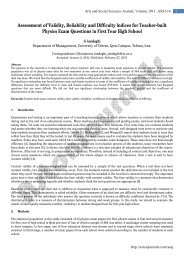
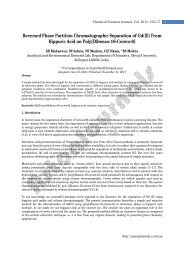
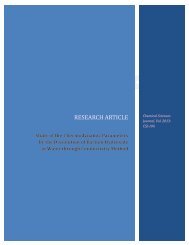
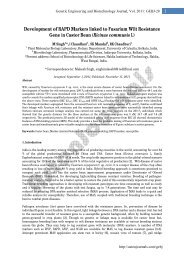

![[1,4]-benzodiazepine-2-one Derivatives as Potent - AstonJournals](https://img.yumpu.com/49117784/1/184x260/14-benzodiazepine-2-one-derivatives-as-potent-astonjournals.jpg?quality=85)
